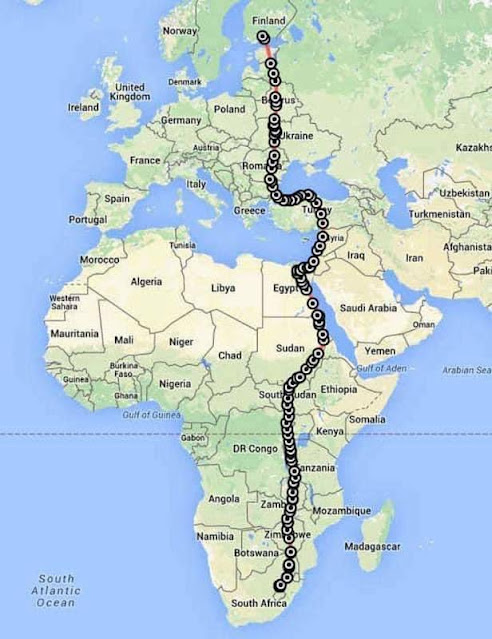Credit to the Royal Society for the Protection of Birds.
"A female European Honey Buzzard was fitted with a satellite tracking system in Finland and was of particular interest to South African locals because it spent the most austral summer (our winter) around the town of Reitz in the Free State in South Africa. She left Reitz in SA to start heading north on 20 April and on 2 June she finally reached Finland where she will probably spend the boreal summer before probably returning again this autumn to South Africa."
The photo shows the data received from the tracker which plots the route that she took to head north... so, in just 42 days, she covered over 10,000 km at an average of more than 230 km every single day!
Had to look up the bird:
The European honey buzzard (Pernis apivorus), also known as the pern or common pern, is a bird of prey in the family Accipitridae.Despite its English name, this species is more closely related to kites of the genera Leptodon and Chondrohierax than to true buzzards in Buteo. The binomen is derived from Ancient Greek pernes περνης, a term used by Aristotle for a bird of prey, and Latin apivorus "bee-eating", from apis, "bee" and -vorus, "-eating". In fact, bees are much less important than wasps in the birds' diet. Note that it is accordingly called Wespenbussard ("wasp buzzard") in German and similarly in some other Germanic languages and also in Hungarian ("darázsölyv").It is a specialist feeder, living mainly on the larvae and nests of wasps and hornets, although it will take small mammals, reptiles, and birds. It is the only known predator of the Asian hornet. It spends large amounts of time on the forest floor excavating wasp nests. It is equipped with long toes and claws adapted to raking and digging, and scale-like feathering on its head, thought to be a defence against the stings of its victims. Honey buzzards are thought to have a chemical deterrent in their feathers that protects them from wasp attacks.
Wish we had one in the back yard to control the yellow jackets.
Reposted after totally rewriting the post based on information from the source, which was located by reader Lones Smith.
Addendum: Gotta share this awesome photo found by reader Crowboy -


Falcon?
ReplyDeletehttps://ww2.rspb.org.uk/groups/southwiltshire/news/481439/
I have completely rewritten the post, deleting the Reddit via with the incorrect species name and replacing it with the info from the RSPB, which leads to more interesting information that what I had initially blogged. Thank you so much, Lones.
DeleteYou are welcome! Your blog is a regular for me.
DeleteThanks. Amazing: https://animalworld.tumblr.com/post/612425038052851712/european-honey-buzzard-pernis-apivorus
ReplyDeleteThank you, Crowboy, for the photo at the link, which I've added to the post.
DeleteSimilar subject is "up" on a local level. In early October, here in the Sacramento Valley, kettles of turkey vultures gather into large masses (I've seen a thousand at a time) and then head south. It's a matter of luck, catching these aggregations.
DeleteThe honey badger of birds L0L your stings mean nothing to me!!
ReplyDelete